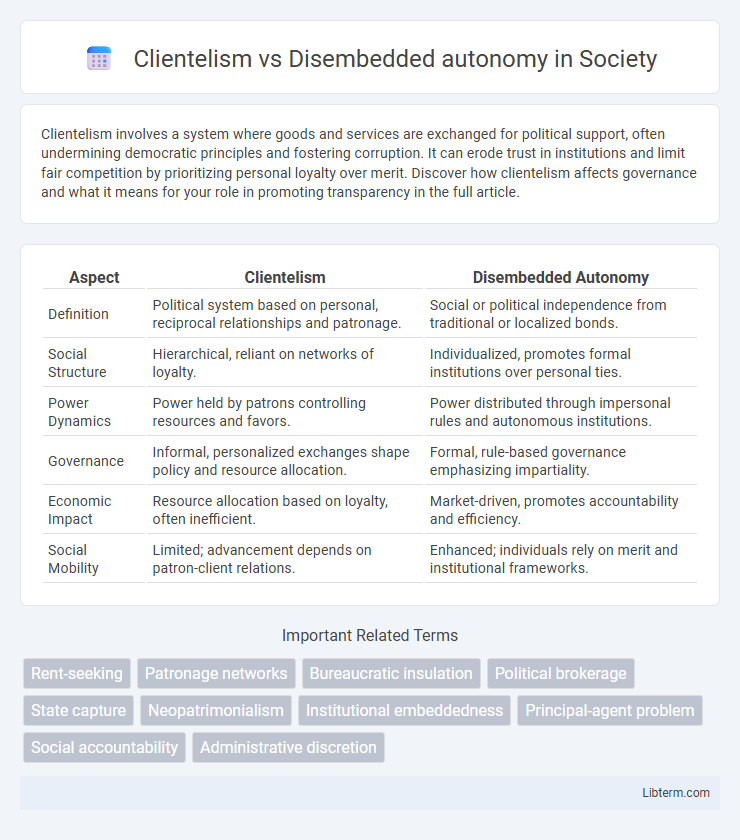Clientelism involves a system where goods and services are exchanged for political support, often undermining democratic principles and fostering corruption. It can erode trust in institutions and limit fair competition by prioritizing personal loyalty over merit. Discover how clientelism affects governance and what it means for your role in promoting transparency in the full article.
Table of Comparison
| Aspect | Clientelism | Disembedded Autonomy |
|---|---|---|
| Definition | Political system based on personal, reciprocal relationships and patronage. | Social or political independence from traditional or localized bonds. |
| Social Structure | Hierarchical, reliant on networks of loyalty. | Individualized, promotes formal institutions over personal ties. |
| Power Dynamics | Power held by patrons controlling resources and favors. | Power distributed through impersonal rules and autonomous institutions. |
| Governance | Informal, personalized exchanges shape policy and resource allocation. | Formal, rule-based governance emphasizing impartiality. |
| Economic Impact | Resource allocation based on loyalty, often inefficient. | Market-driven, promotes accountability and efficiency. |
| Social Mobility | Limited; advancement depends on patron-client relations. | Enhanced; individuals rely on merit and institutional frameworks. |
Understanding Clientelism: Definition and Key Features
Clientelism refers to a social system where relationships between patrons and clients are based on the exchange of goods, services, or favors for political support, often characterized by asymmetric power dynamics and personalized ties. Key features include a hierarchical structure, reciprocal obligations, and an emphasis on loyalty and patronage rather than formal institutions. Understanding clientelism involves recognizing its role in perpetuating inequality and undermining democratic governance by prioritizing private benefits over public interests.
Disembedded Autonomy Explained
Disembedded autonomy refers to a governance model where state institutions operate independently from local social forces and patron-client networks, enabling objective policy implementation focused on national development goals. Unlike clientelism, which relies on reciprocal exchanges and personalized ties, disembedded autonomy emphasizes bureaucratic capacity, institutional insulation, and technocratic decision-making. This model fosters sustainable economic planning and reduces rent-seeking behaviors by prioritizing institutionalized norms over informal social pressures.
Historical Origins of Clientelism and Disembedded Autonomy
Clientelism originated historically from patron-client relationships prevalent in agrarian and pre-industrial societies, where political support was exchanged for material benefits or protection, reinforcing hierarchical social structures. Disembedded autonomy emerged with the modernization and bureaucratization of states, particularly during the rise of industrial capitalism, where institutions gained independence from local social networks and clientelistic pressures. These distinct historical trajectories reflect how clientelism is rooted in personalized, reciprocal bonds, while disembedded autonomy anchors political and administrative power in formal, rule-based systems detached from personal dependencies.
Comparative Analysis: Political Dynamics
Clientelism fosters personalized political support through resource exchange, often undermining institutional autonomy and perpetuating dependency networks in governance. Disembedded autonomy emphasizes state capacity to formulate policies independently of societal pressures, enhancing bureaucratic efficiency and reducing patronage influence. Comparative analysis reveals clientelism weakens democratic accountability, while disembedded autonomy bolsters policy coherence and state legitimacy in political systems.
Effects on Governance and State Capacity
Clientelism undermines governance by promoting patronage networks that skew resource distribution, eroding state capacity through corruption and inefficiency. Disembedded autonomy enhances governance by insulating state institutions from social pressures, allowing for impartial policy implementation and stronger institutional development. The contrast reveals clientelism's negative impact on state capacity and governance quality, while disembedded autonomy fosters effective state functions and sustainable governance structures.
Clientelism and Economic Development
Clientelism, characterized by personalized exchanges and patronage networks, often distorts economic development by redirecting resources toward political allies rather than efficient investments. This system undermines market competition and innovation, leading to inefficiencies and stunted growth in developing economies. Evidence from Latin America and Southeast Asia shows that clientelist practices correlate strongly with lower GDP growth rates and increased income inequality.
Disembedded Autonomy and Policy Implementation
Disembedded autonomy refers to state institutions' capacity to formulate and implement policies independently from particularistic interests and social groups, ensuring coherent and effective governance. This concept contrasts with clientelism, where policy implementation is often compromised by patronage networks and personalized exchanges that undermine institutional integrity. Disembedded autonomy facilitates impartial policy enforcement and long-term development planning, enhancing state capacity to deliver public goods and regulatory frameworks without undue influence from narrow interest groups.
Case Studies: Global Perspectives
Clientelism manifests in diverse global contexts, shaping political landscapes through patron-client networks that influence resource allocation and governance outcomes. Case studies from Latin America reveal entrenched clientelist relationships undermining democratic institutions, while comparative analyses in East Asia highlight instances where disembedded autonomy enables technocratic governance insulated from local patronage pressures. Cross-regional perspectives demonstrate how disembedded autonomy fosters policy innovation and state capacity, contrasting with clientelism's tendency to perpetuate informal power dynamics.
Challenges and Critiques of Each Approach
Clientelism faces challenges such as perpetuating inequality, fostering dependency, and undermining democratic institutions by prioritizing personal loyalty over merit. Disembedded autonomy is critiqued for potentially leading to social fragmentation, lack of accountability, and insufficient integration with community needs due to its emphasis on independent decision-making. Both approaches struggle with balancing effective governance and inclusive representation in political and social systems.
Future Trends: Navigating Clientelism and Autonomy
Future trends indicate a shift toward balancing clientelism and disembedded autonomy as political systems adapt to digital governance and increased citizen activism. Advances in data analytics enable more personalized clientelistic networks, while transparency initiatives and institutional reforms promote autonomous decision-making insulated from patronage pressures. Emerging frameworks emphasize hybrid models where autonomy coexists with clientelistic ties, reflecting evolving governance demands in democratizing societies.
Clientelism Infographic

 libterm.com
libterm.com